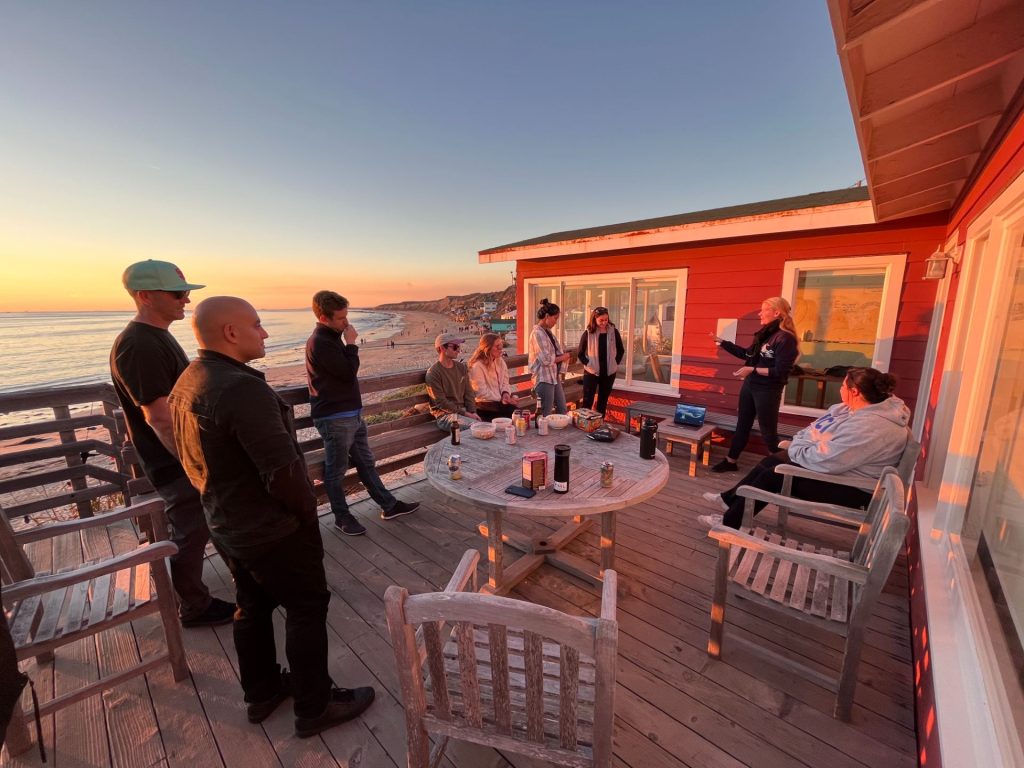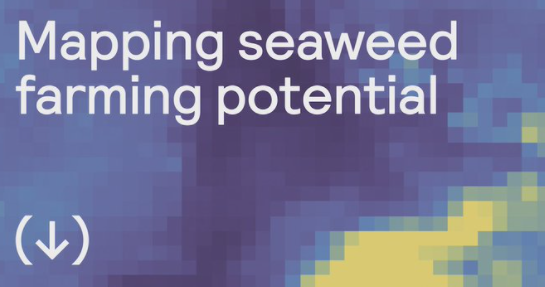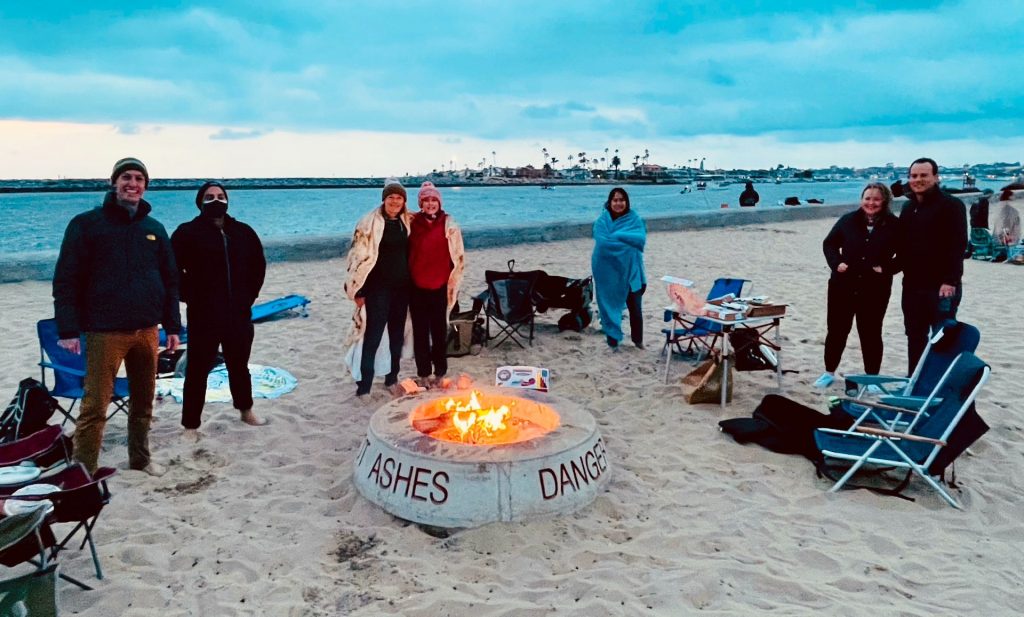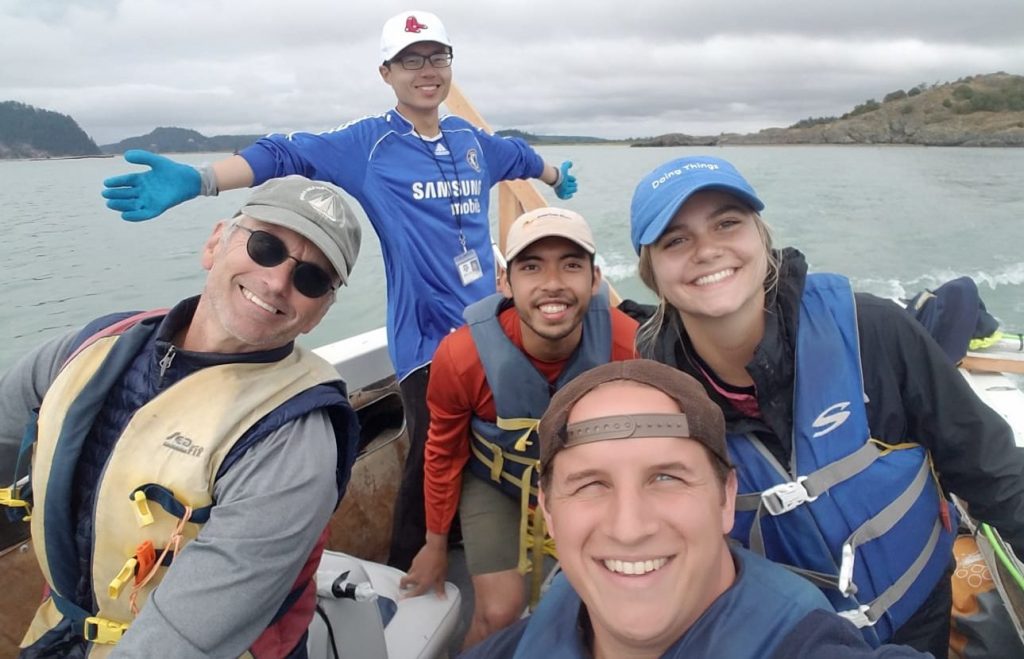
August 2023 – Working alongside Ocean Rainforest Kelp Farm to Inform Kelp Modeling
To groundtruth and improve the MACMODS kelp growth model, we are working with Ocean Rainforest, Inc. to collect observations on the first offshore Macrocystis pyrifera farm in US waters.
Observations of currents, waves, temperature, salinity, oxygen, chlorophyll fluorescence, and nitrate concentrations will be used to characterize oceanographic conditions that influence kelp growth.
March/April 2023 – Sailing for Science (and avoiding pirates)!
The UCI Coastal Dynamics Lab took off on a scientific sailing adventure to study upwelling in the Gulf of Panama this month. The Max Planck Institute’s vessel, the S/Y Eugen Siebold, was in the port of Panama City, Panama, which enabled this exploratory cruise. The crew got lucky with winds (a strong upwelling-favorable wind cooperated with our sampling plan and good data was obtained!), however pirate activity in the area forced us to modify our cruise from the original plan… arrrrrgh! Well, now at least we have some pirate stories!
March 2023 – Madolyn receives the NSF Graduate Research Fellowship!
We are thrilled to announce that Coastal Dynamics Lab graduate student extraordinaire, Madolyn Kelm, has been awarded the prestigious NSF National Graduate Research Fellowship! This award comes with three years of support for Madolyn’s PhD journey. Congratulations, Madolyn!
Madolyn plans to study the dynamics of seaweed cultivation for several possible end uses: first, as a strategy for soaking up anthropogenic inputs of nutrients nearshore, as a feedstock for biofuels, and as a potential mechanism for sequestering carbon.
December 2022 – New Paper on the Potential of Seaweed Farming to Mitigate Climate Change
UC Irvine ESS graduate student, Julianne DeAngelo led a paper in Nature Plants that estimates the economic and biophysical limits to seaweed farming for climate change mitigation. The study shows that, under the most optimistic assumptions, sinking farmed seaweed to the deep sea to sequester a gigaton of CO2 per year costs as little as US$480 per tCO2 on average, while using farmed seaweed for products that avoid a gigaton of CO2-equivalent GHG emissions annually could return a profit of $50 per tCO2-eq. However, these costs depend on low farming costs, high seaweed yields, and assumptions that almost all carbon in seaweed is removed from the atmosphere (that is, competition between phytoplankton and seaweed is negligible) and that seaweed products can displace products with substantial embodied non-CO2 GHG emissions. Moreover, the gigaton-scale climate benefits we model would require farming very large areas (>90,000 km2)—a >30-fold increase in the area currently farmed. Our results therefore suggest that seaweed-based climate benefits may be feasible, but targeted research and demonstrations are needed to further reduce economic and biophysical uncertainties.
December 2022 – Lab Retreat!
The UCI Coastal Dynamics Lab headed down to Crystal Cove State Park to hold an all-day lab retreat. We shared science, snacks, far too much coffee, and laughs at Cottage #22 in the Historic District in Crystal Cove State Park.
October 2022 – Ocean Visions Report on Sinking Seaweed Released
Kristen Davis participated in an international expert working group led by Ocean Visions and the Monterey Bay Aquarium Research Institute (MBARI) to release a new report to guide the necessary research to determine the efficacy and impacts of cultivating and sinking macroalgae for the purpose of sequestering carbon. The report details the scientific questions that need to be answered along with recommended approaches, guidance on experimental designs, estimates of the costs of field trials, and budgeting tools. Work from CDL member, post-doc Isabella Arzeno-Soltero, and UCI graduate student, Julianne DeAngelo, was used and referenced in the Ocean Visions report. (Isa’s paper; Julianne’s paper)
July/August 2022 – Kelp Farm Study in Santa Barbara
Alongside our seaweed farm partners, Ocean Rainforest, Inc., we carried out an observational campaign on a Macrocystis pyrifera farm just offshore of Santa Barbara, California. Measurements of currents, water column stratification, nitrate, and turbulence were collected throughout the farm for comparison to the MACMODS seaweed model. These measurements will help us to improve the model and better understand how circulation within the farm influences kelp growth.

June 2022 – New paper on internal wave transformation in shallow water
Dr. Greg Sinnett, a CDL postdoc, led a paper published in the the Journal of Physical Oceanography on the transformation of large-amplitude internal waves into shallow water. The study examines dense and rapidly sampling array spanning depths 500 m to shore near Dongsha Atoll in the South China Sea. Incident ISW amplitudes ranged between 78 m and 146 m with propagation speeds between 1.40 m/s and 2.38 m/s. Fissioning ISWs generated larger trailing elevation waves when the thermocline was deep, and evolved into onshore propagating bores in depths near 100 m. Collapsing ISWs contained significant mixing and little upslope bore propagation. Bores contained significant onshore near-bottom kinetic and potential energy flux, and significant offshore rundown and relaxation phases before and after the bore front passage, respectively. Bores on the shallow forereef drove bottom temperature variation in excess of 10 ◦C and near-bottom cross-shore currents in excess of 0.4 m/s.

April 2022 – New paper on thermally-driven cross shore exchange
Dr. Aryan Safaie, a former Ph.D. student in the CDL, led a paper published in the Journal of Geophysical Research – Oceans on thermally-driven cross shore exchange in steady alongshore currents. The work uses idealized numerical modeling of thermally driven baroclinic exchange to understand how cross-shore flow is modulated by steady alongshore currents and associated shear-generated turbulence. In general, we find that shear-driven vertical mixing reduces the temperature gradients responsible for establishing the baroclinic flow, such that cross-shore thermal exchange diminishes with alongshore current speed. Results from this work have implications for tropical reef environments with optically clear water and weak alongshore flow, where surface heating and cooling can drive cross-shore circulation with O(1) cm s−1 velocities. Though exchange velocities are relatively small, these persistent exchange flows are capable of flushing the nearshore region multiple times per day, with important implications for water properties of nearshore ecosystems.
March 2022 – Seaweed-based Carbon Sequestration Online Mapping Tool
The productivity, costs, and potential climate benefits of seaweed farming are spatially heterogeneous and scale-dependent, and it is important to evaluate the key sensitivities and trade-offs relevant to investors and decision-makers. We have developed coupled biophysical and technoeconomic models (see preprint manuscripts in links) to begin answering these questions. We worked with CarbonPlan to put together an interactive explainer and a mapping tool to make the results more accessible. We also discuss key insights and priorities for future research.
February 2022 – New paper on MACMODS!
Dr. Christina Frieder, a former postdoc in the CDL, led a paper published this month in Frontiers of Marine Science on the MacroAlgae Cultivation MODeling System (MACMODS). The MACMODS model allows us to explore within-farm modifications to light, seawater flow, and nutrient fields across time and space scales relevant to macroalgae. A regional ocean model informs the site-specific setting, the Santa Barbara Channel in the Southern California Bight. A fine-scale large eddy simulation (LES) model predicts modified flows and turbulent mixing within the farm. A spatially resolved macroalgal growth model, parameterized for giant kelp, Macrocystis pyrifera, predicts kelp biomass. Key findings from model integration are that regional ocean conditions set overall farm performance, while fine-scale within-farm circulation and nutrient delivery are important to resolve variation in within-farm macroalgal performance.
January 2022 – Surveying baby kelp
The Coastal Dynamics Lab visited the giant kelp (Macrocystis pyrifera) lines seeded in November 2020 at the Ocean Rainforest farm in Santa Barbara, CA. We are using our MacroAlgae Cultivation MODeling System (MACMODS) to simulate growth at this new pilot farm over the growing season. We’ll also be working with the Ocean Rainforest team this summer to monitor the flows and water properties as the kelp grows!
June – September 2021 – Bahía Almirante
Continuing our NSF-funded work in Panama, we recovered, cleaned, downloaded, and redeployed instruments in Bahía Almirante in the Bocas del Toro region of Panama. Graduate student, Anne Adelson at UCSD and postdoc, Sam Kastner, are working hard to understand the physical processes underlying low oxygen (hypoxia) in the region.
Continuing our NSF-funded work in Panama, we recovered, cleaned, downloaded, and redeployed instruments in Bahía Almirante in the Bocas del Toro region of Panama. Graduate student, Anne Adelson at UCSD and postdoc, Sam Kastner, are working hard to understand the physical processes underlying low oxygen (hypoxia) in the region.
March 2021 – New CDL Lab in ISEB
The Coastal Dynamics Lab moved to the new Interdisciplinary Science and Engineering Building (ISEB), Room 1510. We are excited to have a new space for preparing and launching coastal field experiments. It won’t come as much surprise that our first in-lab work was kelpy in nature!
February 2021 – Emma & Aryan Defend!
Congratulations to Dr. Emma Reid and Dr. Aryan Safaie for successfully defending their dissertations! Two CDL defenses in one week! You both made us proud. We celebrated with a socially-distant beach bonfire on Pi Day (with pie, of course)!
November 2020 – New DTS methods paper
Postdoctoral researcher, Dr. Greg Sinnett, led a paper published in the Journal of Atmospheric and Oceanic Technology that addresses methodological considerations for the use of distributed temperature sensing (DTS) systems in oceanographic environments, including DTS configuration, calibration, and data processing challenges.
September 2020 – Virtual CDL Group Meetings
This isn’t really new news… we’ve been meeting like this for a while now (6 months!), but today we got a good Zoom shot of us all (thanks, Christina!) and it’s worth posting. Hopefully, one day soon we’ll be back to meeting in person, but until then I’m grateful to have this crew to talk science with.
August 2020 – Annual Reviews of Marine Science – Turbulence and Coral Reefs
An advance version of our Annual Reviews of Marine Science article on Turbulence and Coral Reefs has been posted online. The interaction of coral reefs, both chemically and physically, with the surrounding seawater is governed, at the smallest scales, by turbulence. In this article, we review recent progress in understanding turbulence in the unique setting of coral reefs—how it influences flow and the exchange of mass and momentum both above and within the complex geometry of coral reef canopies.
August 2020 – Outreach with Project Scientist
Kristen Davis (virtually) joined a Project Scientist camp during “Energy and Climate Change Week” to give a STEM Superstar presentation to girls aged 8-12. We talked about the tools that oceanographers use (satellites, ships, computers, scuba diving) to learn about the ocean and about how climate change affects the ocean and organisms from big (whales!) to small (plankton). Here’s hoping there are some future oceanographers in this group!
May 2020 – New paper!
New paper out of the CDL in the Journal of Geophysical Research, “Fate of internal waves on a shallow shelf.” We report novel observations from a distributed temperature sensing (DTS) system that tracked the transformation of internal waves from the shelf break to the surf zone over a narrow shelf slope region in the South China Sea. The spatially continuous view of temperature fields provides a perspective of physical processes commonly available only in laboratory settings or numerical models, including internal wave reflection off a natural slope, shoreward transport of dense fluid within trapped cores, and observations of internal rundown (near‐bed, offshore‐directed jets of water preceding a breaking internal wave).
February 2020 – Ocean Sciences Meeting
The Coastal Dynamics Lab presented our work in two talks and four posters at the 2020 Ocean Sciences Meeting in San Diego, CA. Here, CDL graduate student, Sarah Merrigan presents some hot off the presses data from her work in the Dongsha Atoll lagoon.
January 2020 – Field work in Panama
More fieldwork in Bocas del Toro Panama! Turning around moorings and collecting transect data within the bay. Here, Sarah Giddings, Geno Pawlak, KC Clark, Kristen Davis, and Sebastian cruise the rivers flowing into Bocas del Toro to take some measurements. These rivers are an important source of fresh water into the bay and likely nutrients as well.
October 2019 – New paper!
Emma Reid, CDL graduate student, published her first paper in Limnology & Oceanography which demonstrates that internal waves shoaling on a shallow atoll regularly transport cold, nutrient-rich water shoreward, altering near-surface water properties on the fore reef. This water is transported shoreward of the reef crest by tides, breaking surface waves and wind-driven flow, where it significantly alters the water temperature and nutrient concentrations on the reef flat. This work highlights the importance of internal waves as a physical mechanism shaping the nearshore environment, and likely supporting resilience of the reef.
September 2019 – Field work in Panama
Fieldwork in Bocas del Toro, Panama studying the physical drivers of hypoxia in a tropical bay. This project, funded by NSF, involves researchers from the Smithsonian Tropical Research Institute (Rachel Collin, KC Clark), UCSD/SIO (Geno Pawlak, Sarah Giddings) and the UC Irvine Coastal Dynamics Lab. Here, Jenn Yin, a Stanford graduate student, is learning to replace the shear probes on our Rockland Scientific MicroCTD before launch.
August 2019 – Learning about the Coastal Ocean
CDL member Sarah Merrigan attends the Estuarine and Coastal Fluid Dynamics Summer course at Friday Harbor Labs making new science friends and sampling the Skagit River!






















